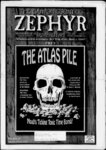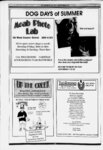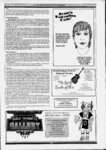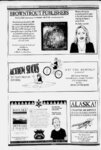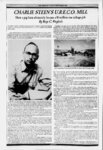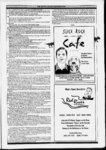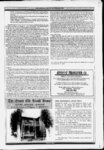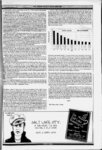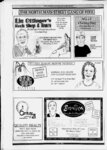| OCR Text |
Show CAP IT WHERE IT IS The Atlas Corporations former project engineer expresses a dissenting view. By Robert S. Pattison Dear Jim, Thank you fat giving me this chance to provide an article for your special issue Country Zephyr on the Atlas tailings. These comments are my beliefs, not Atlas's. by them, or being paid for this letter. Of The Canyon I am neither employed My background is in engineering and applied science and I have over forty years of expe-rience working in England, Africa, Canada and the United States in the design engineering, and the mining businesses. My mining experience indudes most aspects of recovering copper, cobalt, precious metals and uranium. I have worked in the uranium recovery business and related environmental fields of work since my family and I moved to Moab in 1974. One of my major projects was to design, develop, and implement a reclamation plan for a uranium mill, that induded design of flood protection plans and the resolution of groundwater I was then contract project engineer tor Atlas Corporation and oversaw the problems. steel-makin- g, decommissioning of their mill and interim tailings cover. I have read and understand most of the technical reports on this mill tailings issue and have followed its progress in detail since 1995. My knowledge and experience should thus qualify me to make these comments. When you called you said you preferred that foe pile be removed, but did not explain why. If this tailings pile is removed it will force Atlas Corporation into bankruptcy and conservatively cost taxpayers an extra $100 million. Spending such large amounts of money can not be justified merely because we do not like the look of the tailings pile, or where it is located. It should rather be based upon verifiable facts that prove reclamation constitutes an unacceptable hazard, or does not comply with current laws. In 1993, a small group of vociferous people and their followers were unhappy with Atlas's plan to reclaim the Moab tailings pile in place, next to foe Colorado River. They disagreed with NRCs finding of no significant impact (FONSI) for this plan and called for a new technical evaluation report (TER) and environmental impact statement (EIS) on the project and persuaded Senator Hatch to write to NRG Much to the amazement of the engineers and scientists familiar with this project, NRC agreed to withdraw its FONSI and agreed to complete a new TER and EIS. Their new TER was completed in 1996 and a new EIS is now complete except for a final biological opinion from the U. S. Fish & Wildlife Service (F&WS). NRCs new analyses reinforce their previous FONSI and maintain that reclamation is acceptable and they are thus to EIS issue the new and approve Atlas's plan for reclamation. I also favor expected reclamation, for the following reasons: No matter how much care is taken, or how the job is done, removing this tailings pile will result in significantly increased environmental and health risks from inevitable spillage and dust and from increased radon emanations. Hie workers' increased exposure will be rigidly controlled and monitored, but exposure of the general population, inducting tourists, will be difficult to control because they also will be subjected to correspondingly increased health risks, Knowing the curiosity of people, this is a real risk to take, especially with an accident that involves a large amount of spillage. Moving the pile will create the possibility of contaminating the land between the sites next to foe Arches National Park and Moab's tourist entrance road, (8) No matter how much care is taken, or how the job is done, moving the pile to a new location will result in significantly increased transportation risks. Based upon known statistics, this could realistically result in one accidental death. Similar work completed by the DOE in South Dakota and Grand Junction resulted in three deaths, I believe. The effect of moving the pile on our growing tourist industry could be economically devastating during the time it will take to do the job. Several prominent motel owners and businessmen in Moab agree. There is also the stigma that is associated with SuperFund sites that may not be good for a tourist town. (10) No matter how the job is done, or who does it, removing the pile to a new location will cost the taxpayer at least $100 million more than capping it in place. After catering for everyone's desires, and possible cleanups, it might cost $1 billion! (9) post-accide- nt in-pla- ce in-pla- ce in-pla- ce in-pla-ce (1) Reclaiming foe tailings pile in place will have the least overall long-ter- m detrimental health and environmental impact reclamation plan design is excellent and makes the best possible use of materials. (2) The It is a bargain for foe taxpayer and meets the intent of Appendix A regulations (10CFR40) for reclamation of uranium tailings (NRCs primary objective), and recognizes the Atlas site existed before the Uranium Mill Tailings Radiation Control Act (UMTRCA). (3) There is no significant water quality problem with the Colorado River attributable to the Atlas tailings pile and, the present situation can only continue to improve with time after the tailings are reclaimed in place; it can never get worse. (4) If the pile is moved, there will be no measurable difference in Colorado River water quality. Thuai, nothing can be achieved by removing the pile with respect to river water quality. due (5) Regardless of if the pile is removed, it will be impossible to ever use site ground-watsaline of the that saltier sea three times (10 salts; than to underlying highly water, or roughly Great Salt Lake) natural solutions. (6) If foe pile is removed, a second contaminated site will be created. There will then be two contaminated sites instead of one, which is contrary to Appendix A regulations. (7) The radioactivity in the tailings pile is harmless, as long as it is not disturbed. The hazard of materials into the air, since inhalation of created by moving a tailings pile is the stuff is the real danger. in-pla- ce er The adverse effects of moving this pile are perhaps not understood andor are ignored by some special interest groups, most of the news media, and several politicians, for example, when Representative Cannon was interviewed by Beat Kelly on the radio last year, he was unsure about increased risks from transportation accidents, atmospheric emissions, and the possible negative impacts to Moab's tourist industry. The increased health and environmental risks should be carefully considered before any decision is ever made to remove this tailings pile. Accordingly, this pile should be reclaimed in place unless proper justification is provided to warrant Us removal No such justification has yet been provided. Admittedly, three organizations (National Park Service, US Fish & Wildlife Service, and the Grand Canyon Trust) and interested parties have provided information that appears to warrant moving the tailings, but their arguments do not give equal weight to all the facts and, in many cases, are plainly wrong. For instance, in their initial Draft Biological Opinion, F&WS repeatedly used foe following false arguments to justify their obvious preference for foe relocation option. One argument stated 19 times that river water usage (required for compaction and dust reclamation is detrimental because it takes, or depletes, water from the river. control) for What it did not say was that it will take at least twice the amount of water (also required for compaction and dust control) if the pile is mooed. Therefore, this argument is irrelevant, or even deceptive, and should not be used to justify moving the tailings. F&WS's second argument to support their position was based on their opinion that the tailings pile pollutes the Scott Matheson Preserve, on the other side of the river. This is impossible because the center of the river is a ground water divide, or a final sink from both sides of the river. In other words, pollutants can not cross the river. If they could, the higher levels of some constituents that exist on the Matheson side of the river would migrate to the Atlas pollutants always diffuse in the direction of lower concentration. Nevertheless, F&WS chose to ignore advice from the EPA, NRC and the U. S. Geological Survey and insisted many times in their Draft Biological Opinion that Atlas was polluting the Matheson Preserve. Both these F&WS arguments are unconditionally insupportable and should not be used to justify moving the tailings pile. In addition, FAWS failed to recognize that moving the pile will make no difference to Colorado River water quality. Yet, detractors exdaimed --..at last, we have a real scientific report..." when interviewed by the news media about this report. I strongly disagree with this flattering but unwarranted statement. F&WS's initial Draft Biological Opinion mwaraBM in-pla- ce |
